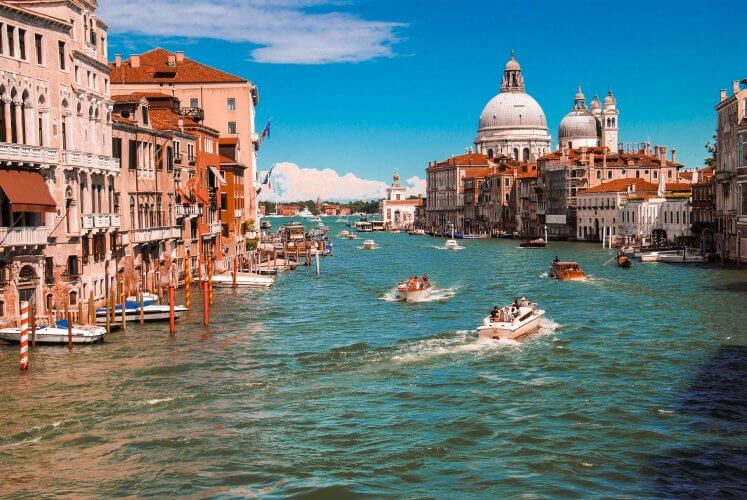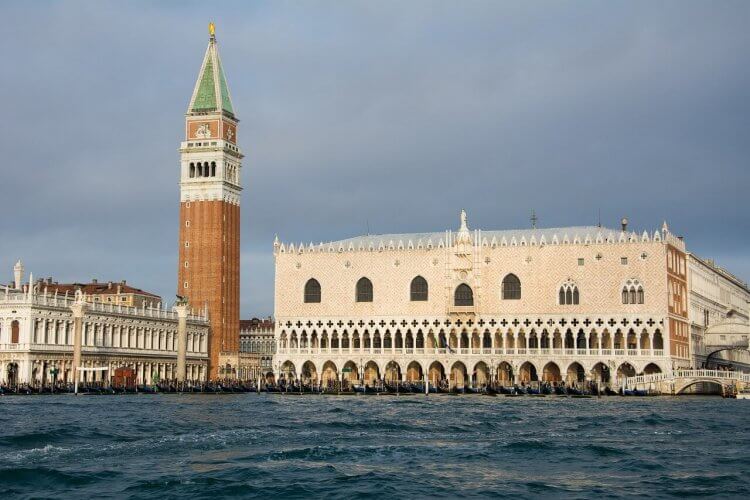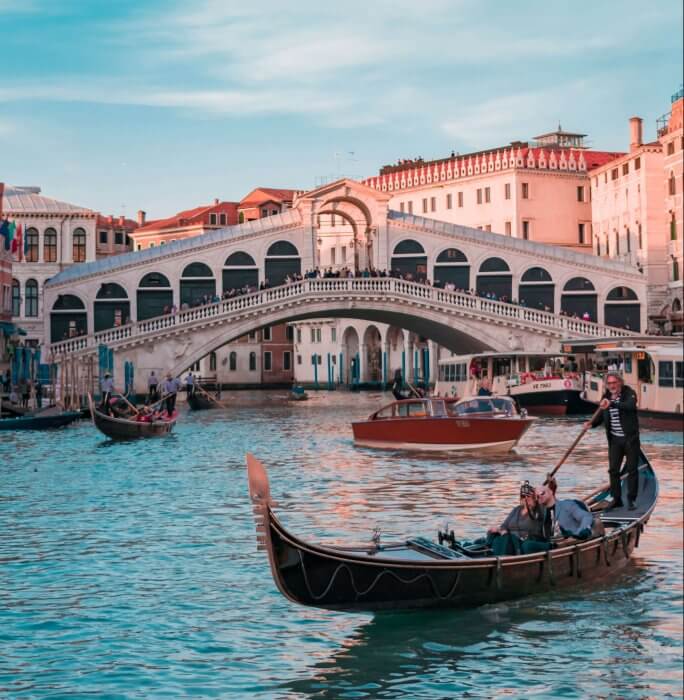A Complete Guide to Visiting Venice
There’s few of us who haven’t daydreamed of floating along the pea green canals of Venice, gazing up at 16th-century architecture whilst listening to the song of a Venetian Gondolier. There are some who would argue that the romantic merchant city of Venice is long gone and that Venice is now little more than an oversized tourist trap. There may be some truth in this line of thinking but that by no means takes away from the unique charm, beauty, and intrigue of the floating city. After five months of living in Venice, I can tell you that there is more to this historic city than first meets the eye.

Understand Venice
As most of us know it, the city of Venice was founded on trade. The exchange of lace, silks, glass, porcelain, salt, spices, and valuable metals with traders in Egypt, the middle east, and Asia. It remained separated from the Republic of Italy for centuries due, mainly, to a small stretch of shallow water. What many people don’t know is this same body of water is what brought the first frightened inhabitants to the Venetian lagoon in search of a refuge after the fall of the Roman Empire.
When the first inhabitants arrived, there was no Central Venice but over 100 individual islands so families built their homes, opened shops, and built churches on their own island. Over time the islands have been linked by bridges and many canals have been filled so that you can now walk from one side of the city to the other without ever getting your feet wet.
The Grand Canal passes through the middle of Central Venice with three bridges crossing it. The surrounding water is known as the Venice Lagoon and it includes many small islands, some of which are uninhabited or private.
When to Visit
It is, of course, possible to visit Venice at any time of the year, but if you have the option then I would recommend visiting before or after the high season.
From mid-May to mid-September Venice’s top attractions are guaranteed to be jam-packed with flashing cameras and impenetrable crowds. Likewise, the price of accommodation skyrockets, and that’s if you can find any free accommodation. It’s also very hot and humid during these months and mosquitos attack in force.
Instead, plan to visit between March and May or between September and November. At this time the weather is still pleasant and crowds reduce, prices drop, and lines for attractions are shorter. Students also come back to the city for the University term so the nightlife is significantly more local.
Venice is also very beautiful during the winter time but be aware that there is a greater risk of flooding and that some hotels and restaurants close for the winter.
Where to Stay
Budget Hostels: there are a handful of hostels in Central Venice but none of them fall into the ‘budget’ category. Most will cost between €30-€50 even during low season. A better option is the Generator Hostel on Giudecca Island, it’s clean and has an onsite bar/restaurant on the ground floor and a takeaway pizza place nearby. Just remember to budget for the Vaporetto service to and from the island. Another option is to stay at one of the campsites on the mainland. These campsites rent tents and some have cabin dorms for up to €20 so there’s no need to pack camping gear.
Budget Hotels/Air B&B: Avoiding Rialto and San Marco Neighbourhoods you can find some budget hotels which, for pairs or groups are better value than hostels. You’ll probably have breakfast included too. Air B&B’s are defiantly the most economical for groups. There are many located in residential areas such as Santa Croce, Cannaregio, Castello, and Dorsoduro.
Long Term Accommodation: long-term accommodation can be difficult to find in Central Venice particularly during the peak season as many private properties have been converted into Air B&B’s. That said, students tend to travel during the summertime so shared rooms and flats do become available. There are a few Venice accommodation groups on Facebook so you can contact the owner directly and it’s worth taking a look on the Erasmus accommodation page too. Cheaper rentals are available in Mestre but don’t expect to find a shared flat in Central Venice for less than €400 per month.
Where to Eat
You can barely move for restaurants in Venice. A favourite for locals in the Rialto area is the Osteria al Diavolo e L’acquasanta. Located on a small side street the restaurant serves typical Venetian dishes and it’s not uncommon to see a worn-out Gondolier dropping in for an espresso.
For something light stop by one of Venice’s wine bars for Cicchetti (Italian Tapas). A popular joint is Al Timon, which is located alongside a canal in Cannaregio district. You’ll find it overflowing on summer evenings but don’t worry because if there are no tables left then you can always take a seat in their wooden boat.
https://www.instagram.com/p/BkZywR_gX8d/?
For something to eat on the go, stop into one of the pasta-to-go places near San Marco Square or at Frito Inn on La Strada Nuova.
Venice for Vegans/Vegetarians/gluten-free:
As you probably already know, Italian cuisine already has many options for vegetarians and I’d be surprised if any restaurant in Central Venice didn’t have at least one veggie pasta dish, risotto, and pizza. Likewise, many places now stock gluten-free pasta. Although there are only a few all vegan restaurants in Venice most eateries will be able to cook up something meat and dairy free. If not, salad is a fail-proof back up.
Nightlife

Venice is not known for its wild parties and rave bars so if that’s what you’re after then you’d be better off visiting Budapest or Berlin. Instead, Venice offers trendy wine bars and hidden clubs with billiards and live music. Santa Margarita Square is where Venice’s youngsters go to socialise after lectures have ended. Here you can drink Aperol Spritz, Prosecco, or cocktails at Duchamp’s and listen to music till 2 am.
Public Transport
To the San Marco Airport: this airport is closer to the city centre and there are two ways of getting there by public transport. First is the Alilaguna Vaporetto Service which crosses the lagoon and stops along the Grand Canal before continuing to San Marco Square and Lido Island. The second option is to take the bus to/from the Piazzale Roma. This is the cheaper option and also more convenient if you’re flight is very early/late.
To Treviso Airport: located about 1 hour from Venice, Treviso receives Ryanair flights. There is a regular shuttle bus service from outside the airport to Venice Piazzale Rome bus station, stopping in Mestre on the route.
In the City: the transport system in central Venice takes the form of the Vaporetto which is basically a floating bus. There are multiple lines which make stops along the Grand Canal and go to Islands on the Venice Lagoon.
Single-use tickets are quite pricey for tourists so if you will use the Vaporetto frequently or to visit the islands then it’s better to buy a one to seven-day tourist pass or invest in a Venezia Uncia card if you’re staying long term.
Public buses and trains operate frequently from Venice to Mestre and Maghera from around 6 am to midnight. Some lines operate all night.
https://www.instagram.com/p/BnWI_qjAnXG/?
Cost
Venice is certainly not as cheap as travelling in Southeast Asia but it doesn’t have to cost a fortune either. Assuming that you’re not drinking coffee on San Marco Square, riding around in Gondola’s and that you opt for a hostel outside of Central Venice rather than a 5-star hotel on St Mark’s Square, you should be able to stick to a budget of €40 to €60 per day.
Safety
Venice is a very safe city and, while the stillness of its dimly lit streets may seem a little eerie in the night, I personally never felt unsafe walking home alone at night. Actually, Venice is a very safe city with a low risk of muggings or violent attacks. The main risk is of pickpockets and scammers who tent to hang out on San Marco Square or around the train station. Keep an eye on your belongings and pack your camera, cards and passport into an anti-theft bag and I doubt you’ll have any problems.
Things to do in Venice
1. San Marco Square
https://www.instagram.com/p/Bl-18J3lhmh/?
Despite being the most overcrowded and touristic part of Venice, San Marco Square is also the most impressive. One side of the square is occupied by the glorious Basilica of San Marco whilst the remaining three sides are walled by elaborately carved pillars and brilliant facades. It may be manic during the day and flooded on occasions, but San Marco Square is mesmerizing after dark when the crowds disperse and the square is filled with the rich classical music which spills out of luxury cafes.
2. The Doge’s Palace

The Doge’s Palace was the once the political home of the Venetian Empire and the buildings halls, rooms, and prison cells have plenty of stories to tell. From here you also get the best view looking out to sea from the Bridge of Sighs.
3. Rialto Bridge

The most famous bridge in Venice is one that you’re bound to cross at some point during your stay. It was built out of marble in the 16th century and housed the family businesses of local craftsmen on either side of the stairs. This is a magic place to watch the gondola’s, traghetto’s and Vaporettos come and go.
4. Church of San Giorgio Maggiore
This attraction is often skipped in favour of St Marks Basilica, but I’d argue that the view from the bell tower of this 16th century Benedictine Church is even better. It’s certainly less crowded and you’ll still get a fantastic bird’s eye view of San Marco Square.
5. Rialto Market
https://www.instagram.com/p/BkW-9K2gexa/?
In the heart of what was once Venice’s financial district is Rialto’s fish market. You won’t need a map to get to this place because you’ll catch the scent from a few bridges away. The market is largest on Saturdays and Mondays when it takes over the entire square with fruits, vegetables, and a variety of fish.
6. La Acqua Alta Book Shop
This is, without a doubt, the best second-hand bookstore that I have ever visited. La Acqua Alta Bookshop is somewhere part way between chaos and quirky. Step inside and a gondola of books awaits you (no, that’s not a metaphor), wobbly stacks of Italian novels fill the interior, old road maps make up another pile, books in foreign languages are dotted about, and whilst leafing through printed pictures of Venice through the ages you’ll have to be careful not to disturb the sleeping cats.
7. Watch the Voga Longa
The Voga Longa is an annual rowing race held in May. Competitors take to the water in traditional boats, rowboats, and kayaks and race for 20 miles across the Venice Lagoon. More than 1,500 boats and over 5,000 participants take part in the competition and those who aren’t in the water gather on the banks of the Grand Canal and San Marco Square to watch the event.
8. Visit the Islands
https://www.instagram.com/p/BnS_kwyFyn_/?
Get away from the city centre by taking the Vaporetto to Venice’s islands. The main are islands are Murano, which hosts century-old glass blowing workshops, Burano, known for its colourful houses, laidback atmosphere, and lace making traditions, and Lido di Venezia, which is not particularly historical but it does give you access to a sandy beach.
9. Chill out in the Park
In the middle of summer, my go-to place became the Giardini Pubblici (Giardini della Biennale). Far away from the noise and heat of the centre, you can come with a good book or grab an ice cream whilst watching the Vaporettos pass by. Take a stroll through quiet Castello district to get there, passing Artisenale, a 12th-century shipyard, on the way.
10. Check out the Venice Biennale
La Venice Biennale is an art organisation founded in 1895, each year the program alternates between art and architecture and exhibitions are set up inside Palazzos across the city. The exhibition displays the works of international and forward-thinking architects and artists and celebrates the works of individuals as well as companies. Entrance to the two main exhibitions is €22 but there are also several smaller exhibitions which are free to enter.
11. People Watch and Window Shop
Those who love to people watch are in luck because, with thousands of people trying to find their way in this maze-like city, with street performers playing titanic on glasses, and with several fascinating Venetian characters wondering the streets, you could make a novel with the happening of half an hour on one of the squares. Likewise, Venice’s streets are lined with pricey boutiques, tourist stores, and designer fashion brands. Now I’m not so keen in Gucci or Armani, but there’s something captivating in the window displays of Burano made lace, glass figures, antiques, and vibrant carnival masks.
Like a Local
To see Venice through a local’s eyes take the official Free Walking Tour. The guides are all residents who know the city like the back of their hands. Instead of visiting San Marco and Rialto, which you really don’t need a tour guide to find, the tour takes you through the backstreets of Venice and into neighbourhoods which are rarely found by Venice’s boatloads of tourists. You’ll get to learn a little about the politics in Venice too and the reality of local life in the floating city.
Respect Venezia
I recent years local residents have called attention to the issues caused by the masses of tourist who flood the streets of Venice and arguably cause greater damage to the community than actual floods. In the height of summer, it’s just about impossible for locals to get anywhere on time due to the number of tourists blocking bridges and alleys with selfie-sticks, maps, and suitcases. Then there’s the overfilled trashcans, noisy groups, and oversized cruise ships. Don’t misunderstand though, it’s not that tourists aren’t welcome in Venice. They are. Locals simply ask that visitors are respectful to them and their city. Before visiting Venice take a look at the #enjoyrespectvenezia campaign launched by Citta de Venezia.
Suggestions:
Ditch the map: as I mentioned above, maps simply aren’t practical in Venice. Just try to open one up in the middle of Rialto Bridge or San Marco Square. If you succeed then they’re of limited use anyway and even google maps can’t find your location half the time. Instead, just leave yourself some extra time and be prepared to get lost.
Drink standing up: This is Italy, not the US, and take away coffees are not popular. Actually, Italians generally prefer to drink their espresso whilst standing at the bar. It only takes a minute, only costs €1-2, and you’ll get to use the café’s bathrooms whilst you’re there.
Pasta in a Box: for a cheap and filling dinner skip the restaurants and stop by one of the takeaway pasta shops. A box fresh past in your chosen sauce only costs €5-8 and takes a few minutes to prepare. There are a few good ones next to the Square of Santa Maria Formosa.
Stay Outside the Centre: Accommodation in Central Venice is very expensive and often not that great. You’ll find much better value for money staying in Mestre, on the mainland, from where you can take a bus (€1.50) to the centre.
By Wine from the Barrel: Mostly hidden away on residential streets are a handful of wine stores where, for around €5, you can fill a 1.5-litre plastic bottle with white wine, red wine, prosecco, or local beer, directly from the barrel. I highly recommend taking advantage of this!
Forget flip flops and high heels: Venice is a walking city, filled with countless bridges, uneven ground, cobblestones, and the possibility of flooded streets. Although the riding the Vaporetto is less effort, the best way to discover Venetian architecture, culture, and history is to explore it on foot. Pack a pair of comfy shoes and be prepared to walk.